If you don’t do much banking in person, the art on display in banks on the Outer Cape might be a good reason to venture beyond the app on your phone or the ATM.
The paintings at the various offices of Seamen’s Bank include pieces from its own collection and some that are on loan from private collections as well as a sizable number from the Provincetown Art Association and Museum. Most of the work depicts the local landscape.
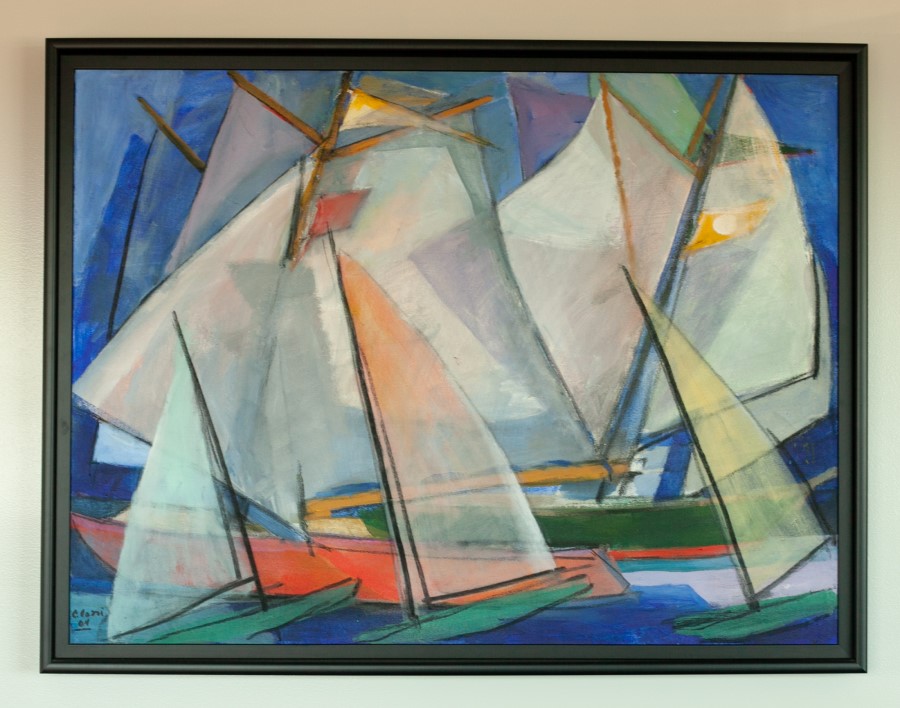
“I’ve been fortunate to have some nice paintings around my desk,” says Amanda Norris, who sits under works by John Clayton and Dorothy Loeb at the Provincetown branch. As a child, Norris took art classes with Salvatore Del Deo, whose painting of a fishing boat hangs in the main lobby. (“I hated the class,” says Norris, citing the long, hot sessions at the Art Association without conditioning. “Plus, Sal wasn’t the most patient back then,” she says, laughing.)
Upstairs at the bank is a pair of brightly colored nautical paintings with overlapping sails by Ciro Cozzi, who opened Ciro and Sal’s with Del Deo. Norris’s parents often spent time at the restaurant with artists like Nancy Whorf, who is represented at Seamen’s by an eight-foot stormy winter landscape in the bank’s board room. Downstairs, behind the tellers, there are two equally dramatic paintings by Charles Kaeselau of rowboats in tumultuous seas.
Two large paintings by Charles Heinz bring the earthy, unmanicured beauty of the local landscape into the polished interior of the Wellfleet branch of Seamen’s. Heinz, who died in 1953, was a farm boy from Illinois who came to study and live in Provincetown. Wellfleet Vista, which appears to have been painted on a hill, depicts a body of water with the town rising on another hill in the background.
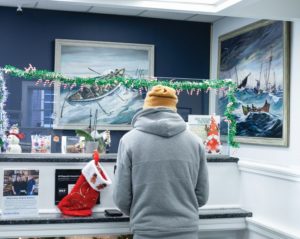
Across the lobby, hanging above a table with banking slips and brochures, is another painting by Heinz of three oyster shacks on pilings teetering above the water. As in his other paintings, their freewheeling energy and unadorned marks are held together by Heinz’s evident mastery of drawing, composition, and color. In the painting of the oyster shacks, the solid form of a blue sky and railroad tracks in the foreground frame the scene.
Most of the artwork at the Wellfleet branch of Seamen’s is also from PAAM’s collection, except for a piece loaned by the Left Bank Gallery and a few from the collection of Steven Roderick. “We like to share our collection with the public,” says Madeline Larson, the registrar and collections manager at PAAM. Given that much of its large collection is in storage — and that space in the museum is limited — PAAM collaborates with local institutions to get art into public view. (Works from PAAM’s collection are also displayed at Seashore Point Wellness Center and in the law offices of La Tanzi, Spaulding & Landreth and David Marshall Datz.)
“In general, it’s places where we have either a donor relationship or it’s a place we feel will be a good public repository,” says Larson. PAAM Executive Director Christine McCarthy is responsible for deciding which artworks are displayed in outside locations.
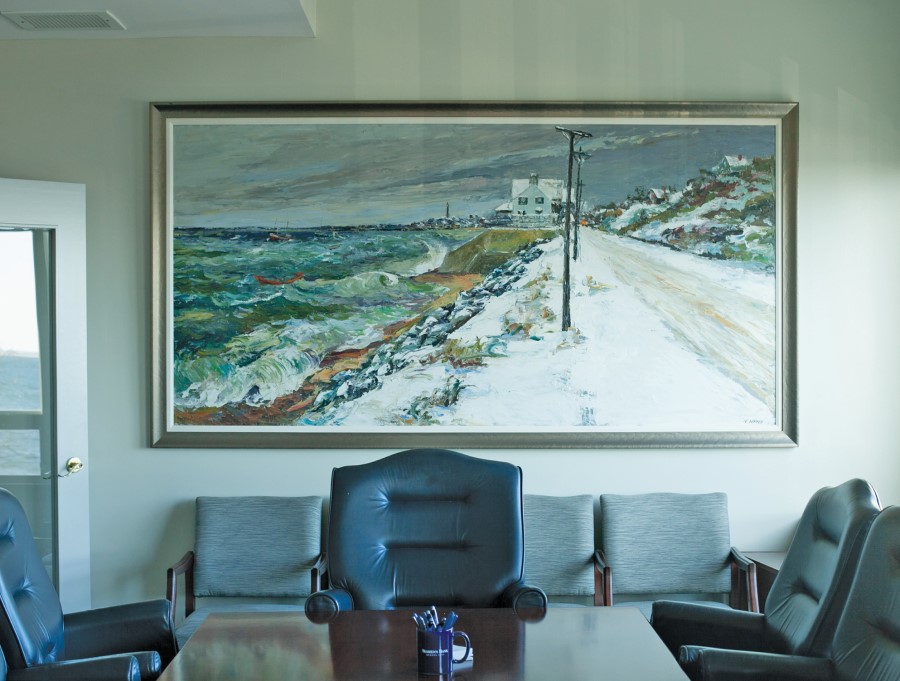
There are other historical gems in the Wellfleet bank, including another moody painting by Kaeselau of a man rowing a boat through icy waters. The carcass of a ship haunts the foreground, and the landscape is reduced to large blocks of cool colors while the sky is bruised in shades of yellow and purple. On the wall behind the teller hangs a Ross Moffett painting and a pale watercolor by Marston Hodgin: another view of the same oyster shacks that Heinz painted.
In addition to the historical paintings, the bank features work by contemporary artists including Bob Henry, Joyce Zavorskas, and Helen Miranda Wilson. Wilson’s unsettling painting of a pair of shoes is one of the few nonlandscape works on display. Wilson draws our attention to peculiar details in the composition — a square heel and disembodied socks — through her insistent, careful observation.
There’s another image of Wellfleet’s bygone oyster shacks along with a painting of cranberry farmers — both evoking a social realist vision of local workers — on the other side of town at Cape Cod Five Cents Savings Bank on Main Street. The two pieces are owned by the bank, which has acquired artwork since its founding through capital improvement budgets.
“We try to be in keeping with artists from the community or artwork featuring the community,” says Kim Howes, vice president of retail services for Cape Cod Five. The bank’s Orleans branch features a broad array of paintings by local artists, including a standout work by the late Arthur Cohen: a dreamy image of Provincetown as a sliver of land between purple expanses of water and sky.
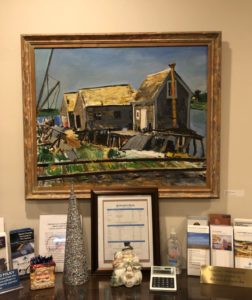
But aside from the two social realist pieces, the Wellfleet branch is currently empty of artwork. One wall that used to host exhibitions of community artists displays nothing except the clear strips that were used for hanging pictures.
“In the past, we allowed outside organizations to display artwork in our banks,” says Howes. “We are suspending that as of January 2023.” The new policy, established by an executive management committee, affects all Cape Cod Five banking centers.
“A lot of people would come in and take a look at the artwork,” says Wil Rhymer, a previous manager at the Wellfleet branch and current assistant vice president and manager at the Provincetown branch of Cape Cod Five. “It was good for the community.”
Rhymer says that the space was used for exhibitions since 1989, when artist Blossom Newman started organizing shows. The responsibility then passed to Maura Ghedini.
It was good for both viewers and artists, says Lew Schwartz, a photographer from Wellfleet who has shown twice at the bank and was planning an exhibition of his work last June that never happened. “Unless you have gallery representation, you don’t have a lot of opportunities to show. It was a great place for an unaligned artist.”
Ghedini and Schwartz had a disagreement about scheduling over the summer, though, Schwartz said, and the exhibition policy changed soon after. Rhymer says he was not involved in the decision to suspend the program, which happened after he left the Wellfleet branch.
“There was a lot of due consideration of the decision,” says Howes. She said the bank worried about the safety of the artwork and customers who had to navigate through installations with “hammers, nails, and ladders,” though neither she nor Rhymer could recall any safety issues in the past.
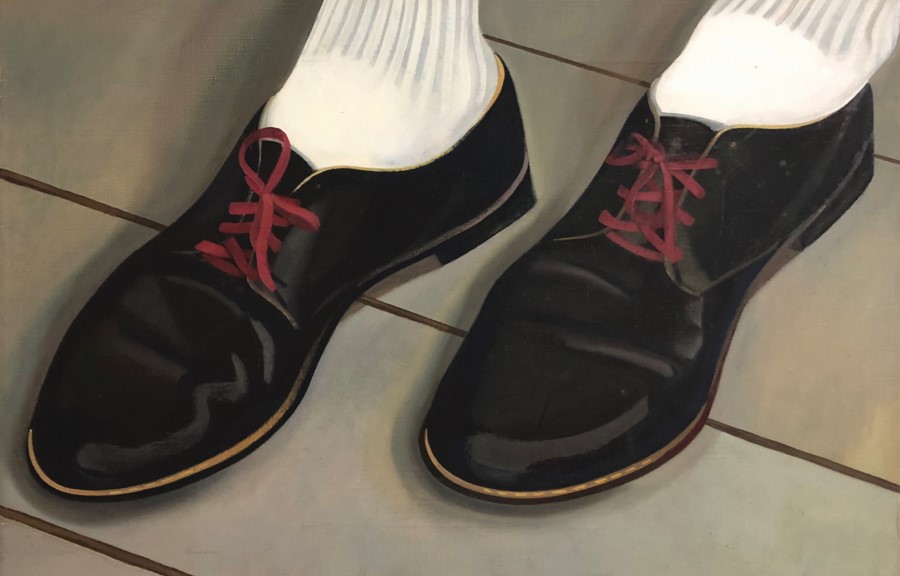
“In some instances, exhibitions were changing out every other month,” says Howes. “That’s a lot of logistics to deal with.”
Then there is the changing role that banks play in the community.
“As banking continues to evolve, it’s less transactional and more advice-related,” says Howes. Bank interiors are beginning to reflect this change: Howes cites two major renovations, one in Yarmouth and another in East Harwich, where new layouts feature “less of a traditional teller line.” Instead of creating places for customers to engage with artwork, the decor is focused on branding.
“Our logo is more prominent,” says Howes, and staff portraits hang on the walls in the bank’s Hyannis headquarters.
But that doesn’t mean the bank won’t also display art. Rhymer says that, although there’s no art yet on the walls of the newest Cape Cod Five branch in Provincetown, “We’re working on that. The branch will work with the marketing team to make sure the artwork reflects the community.” Work from a recently closed operations center in Orleans may be reallocated to other locations, including Provincetown.
And what about that empty wall in the Wellfleet branch, which served as an informal community gallery for over 30 years? Its fate is still undetermined, but Howes says that’s being worked on, too.
“It will likely be a combination of branded marketing and local imagery,” she says.
Editor’s note: An earlier version of this article, published in print on Dec. 15, 2022, suggested that the Charles Heinz painting Wellfleet Vista was painted on Cannon Hill. That seems to be inaccurate, as art collector Michael Parlante has informed us that it was more likely painted near Mill Hill.
